Physical Address
304 North Cardinal St.
Dorchester Center, MA 02124
Blood vessels are, in the simplest of terms, the plumbing of the body. Problems arise when blood flow is diminished, excessive, in the wrong direction, or when leaks occur ( Table 1-1 ). In reality, blood vessels are complex organs within other complex organs. The degree of vascular disease that can be tolerated before symptoms occur varies with the type of blood vessel, the nature and metabolic state of the perfused organ, and the patient. Just as vascular disease can affect an organ, disease in an organ can affect its blood vessels. Often, vascular pathology can result in loss of limb, organ, or life. The ubiquitous and serious nature of vascular disease makes this a fascinating clinical area. This chapter reviews the basic types of pathology that can occur in blood vessels. The clinical presentation, diagnosis, and therapy of disease in a particular vascular bed or organ are addressed in specific chapters.
| Manifestation | Example |
|---|---|
| Obstruction to forward flow | Arterial and venous stenoses, occlusions |
| Increased forward flow | Arteriovenous fistula, malformation |
| Increased retrograde flow | Varicose veins due to reflux through incompetent venous valves |
| Loss of vessel wall integrity | Aneurysm, dissection, bleeding |
The walls of arteries have three layers: the intima, media, and adventitia ( Fig. 1-1 ). The intima forms the interface between the artery and the blood. Composed of endothelial cells, fibroblasts, and connective tissue, this is the site of much arterial pathology. The intima is a dynamic, hormonally active layer that responds to acute stress by release of substances such as prostaglandins and platelet activating factors. Chronic stress, such as turbulence, induces proliferation of the endothelial cells and fibroblasts. Any object in prolonged contact with the intima eventually becomes coated with a layer of new endothelial cells (neointima). In some circumstances, this proliferation results in local obstructive phenomena. The intima therefore has a central role in the natural history of vascular diseases and the outcome of vascular interventions.
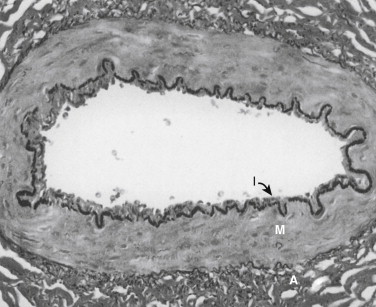
The muscular media is sandwiched between and distinct from the intima and adventitia. This layer provides both structural support for the arterial wall as well as the ability to react acutely to sudden hemodynamic changes. The media is made up of well-ordered layers of elastic fibers, smooth muscle cells, and connective tissue. Smooth muscle cells are orientated in both concentric and longitudinal directions. The normal arterial media is elastic, dilating slightly with each systole and then recoiling during diastole. This is most pronounced in medium and large muscular arteries, and assists in the circulation of blood through the arterial system. In response to demands for increased blood flow the smooth muscle cells relax, resulting in enlargement of the vessel lumen (vasodilatation). Conversely, to restrict blood flow, the muscle cells contract to decrease the diameter of the lumen (vasoconstriction). With aging and certain pathologic conditions (e.g., atherosclerosis), the media loses this elasticity and responsiveness as the smooth muscle cells are replaced by fibrotic tissue or become disorganized. In fact, large atherosclerotic intimal plaques can actually invade the media. The media is also the site of expression of heritable connective tissue disorders such as Marfan syndrome and Ehlers-Danlos syndrome.
The adventitia is a tough yet filmy layer of connective tissue that forms the boundary between the artery and the surrounding structures. This layer contains collagen, fibroblasts, and some smooth muscle cells. Weaving through the interface of the adventitia and media are the small vascular channels (the vasa vasorum) that supply blood to capillaries within the adventitia and the outer third of the media. The inner part of the media and the intima receive nutrients from the blood in the vessel lumen by diffusion. The density of the vasa vasorum is highest in the thickest, most muscular portions of the arteries, such as the ascending and transverse aorta. The adventitia also contains the adrenergic nerves (nervi vascularis) that control vasoconstriction and dilatation.
Veins also have walls with three layers, similarly termed the intima, media, and adventitia . Venous and arterial intima and adventitia are similar in composition and function. The venous intima rarely undergoes the pathologic changes seen in arteries, unless the vein is exposed to arterial pressures, high flow rates, or foreign bodies for long periods of time. Fibrointimal hyperplasia in response to trauma, implantation of endoluminal devices, and increased flow is common. This feature of the venous intimal surface is a major determinant of the long-term outcome of many venous vascular interventions.
The medial layer of veins contains fewer smooth muscle cells than arteries, thus accounting for the relatively thinner, flaccid appearance of the walls. In addition, the connective tissue component of the venous media is less pronounced than that of arteries. As a result, veins contribute capacitance to the circulation. Blood return is facilitated by unidirectional bicuspid valves in the small to medium-sized veins that permit flow only toward the heart. Blood flow is maintained by a combination of processes, including gravity, external compression by muscle contraction, and pressure gradients created during inspiration and expiration. The smooth muscle cells of the small to medium veins can dilate and contract in response to stimuli, thus partially regulating flow.
Atherosclerosis is an arterial disease that is prevalent in industrialized nations. Veins do not develop atherosclerotic lesions unless they are exposed to arterial pressures and flow over extended periods of time. The risk factors for atherosclerosis include environmental and genetic factors ( Box 1-1 ). There are multiple theories of causation, including intimal trauma, an autoimmune response, and infection. Whatever the underlying pathogenesis, the key point is that atherosclerosis is a systemic disease, affecting arteries in all vascular beds. For example, patients presenting with peripheral arterial manifestations of atherosclerosis have risk ratios for ischemic coronary events and stroke over 10 years that are 2-6 times higher than for the general population.
Genetic predisposition
Smoking
Diet
Diabetes
Chronic renal failure
Hypertension
Hyperhomocysteinemia
Advanced age
Dyslipidemia
Obesity
The hallmark of an atherosclerotic lesion is the fibrofatty plaque, which begins as microscopic lipid deposition in areas of intimal injury. Continued injury leads to a fatty streak, an accumulation of foam cells and macrophages that is the first evidence of atherosclerosis visible with the naked eye. As the lesion progresses, the lipid content increases and a fibrotic cap forms over the surface. The cap, composed of smooth muscle cells and collagen, isolates the highly thrombogenic contents of the plaque from the blood ( Fig. 1-2 ). If the cap is disrupted, a shower of cholesterol crystals and debris may flow downstream, producing a potentially devastating syndrome termed cholesterol embolization . More often, platelet aggregation leads to thrombus formation on the exposed surface of the plaque. This thrombus can embolize distally or enlarge to occlude the artery. Plaques that have little calcification and large lipid components are believed to be more prone to this complication, and have been termed vulnerable plaque . These lesions are often clinically asymptomatic until they rupture; they are implicated in many acute coronary and carotid artery syndromes. There is great interest in the development of imaging techniques that would identify vulnerable plaque.
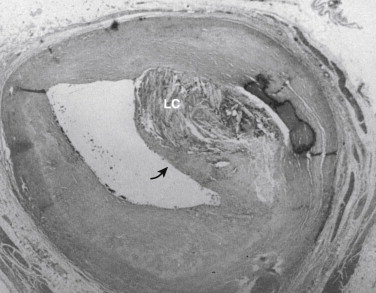
Atherosclerotic lesions can be circumferential, narrowing the arterial lumen in a concentric manner ( Fig. 1-3 ). Plaque that predominantly affects one side of the artery wall results in an eccentric lesion ( Fig. 1-4 ). Longstanding plaque can become quite bulky, calcify, and even protrude into the arterial lumen like a coral reef.
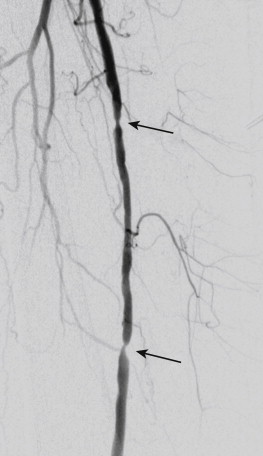
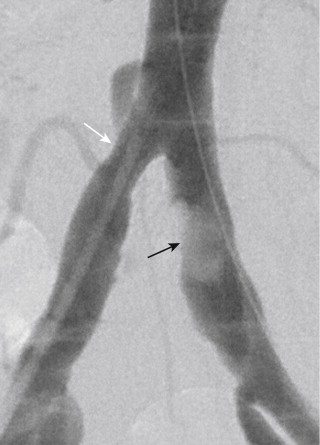
Compromise of the arterial lumen from any cause results in restriction of flow at the site of stenosis ( Fig. 1-5 ). Initially the velocity of flow through the stenotic area will increase, but as the lumen becomes narrower, the flow velocity eventually decreases. In general, a reduction in luminal diameter of 50% (equivalent to a 75% decrease in the area of the lumen) is required before a pressure drop across the stenosis occurs, although many other variables are important. A reduction in diameter of 75% represents a more than 90% decrease in cross-sectional area of the lumen. However, clinical symptoms occur only when the decrease in arterial flow causes end-organ ischemia or dysfunction.
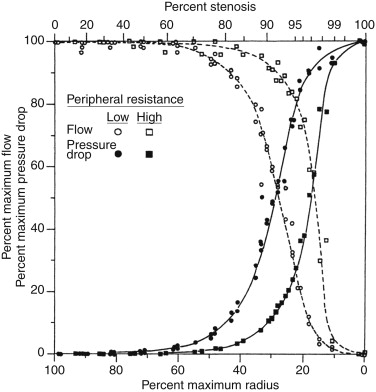
There is a complex relationship between arterial occlusive disease and symptoms. The mere presence of a stenosis does not mean that a patient will have symptoms. The metabolic and pathologic state of the end organ, the degree of collateralization around the stenosis, and the rapidity of onset of the reduced flow are all crucial variables. For example, the classic clinical presentation of chronic lower extremity arterial occlusive disease is ischemic muscular pain with ambulation, relieved by rest. Organs with numerous potential sources of blood supply, such as the colon, are more likely to tolerate gradual onset of occlusive disease than organs with a solitary blood supply, such as the kidney. Gradual onset of occlusion allows existing small supplementary arteries to enlarge, forming a well-developed collateral network that may compensate for most or all of the flow in the original artery ( Fig. 1-6 ). Acute onset of stenosis or occlusion is more likely to produce symptoms, even at rest, when collateral vessels are poorly formed or cannot carry sufficient flow ( Fig. 1-7 ).
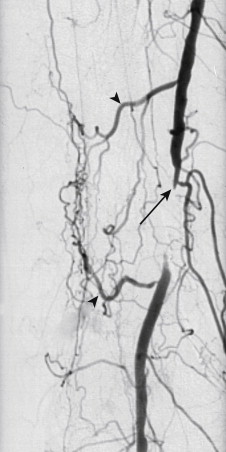
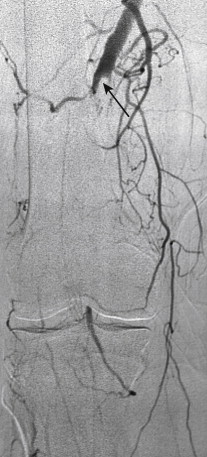
Intimal hyperplasia is not a true disease or disorder, but a complex biologic response to injury to the vessel wall ( Fig. 1-8 ). Whenever the intimal layer of either an artery or vein is injured, fibrin deposition and platelet aggregation occurs. Macrophages and smooth muscle cells quickly migrate into the fibrin-platelet matrix, where they proliferate. Within days of the original injury, endothelial cells appear over the surface of the matrix, extending from the adjacent intact intima or by direct inoculation by circulating endothelial precursor cells. This results in formation of a neointima over the site of injury. Over approximately 12 weeks there is exuberant proliferation of smooth muscle and endothelial cells, such that some encroachment upon the vessel lumen occurs. After approximately 3 months, the entire process may slow or stop, with thinning and stabilization. For reasons that are not well understood, this process is accelerated or prolonged in some patients. The hyperplastic neointimal response can cause narrowing of the vessel lumen that is actually greater and more extensive than the original lesion.
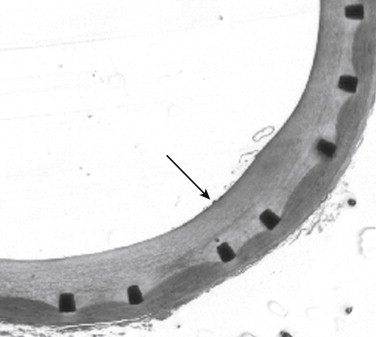
Intimal hyperplasia is the bane of vascular interventions, occurring at surgical anastomoses, angioplasty sites, and after stent deployment ( Table 1-2 ). A number of strategies to reduce intimal hyperplasia have been proposed or are under investigation, including brachytherapy (intravascular radiation), covered stents, drug-eluting stents, freezing balloons, gene therapy, and systemic medications. No single technique has proven entirely successful. Currently, the best results are still obtained by limiting the extent of intimal injury, minimizing the use of prosthetic materials, and maximizing the final diameter of the lumen.
| Cause | Examples |
|---|---|
| Injury | Surgical anastomosis, clamps, angioplasty, excoriation of intima by any process |
| Foreign body | Stents, catheters |
| Abnormal flow | Arterialization of veins, turbulence |
Aneurysms are primarily an arterial disease, although venous aneurysms do occur. Aneurysms may be either “true” or “false,” depending upon whether all three layers of the vessel wall are intact ( Table 1-3 and Fig. 1-9 ). The etiology of the aneurysm determines the type and influences the clinical course.
| Feature | True | False |
|---|---|---|
| Location | Expected | Often unexpected |
| Vessel wall | All three layers intact | Less than three layers intact |
| Etiology | Intrinsic abnormality | Trauma, rupture of true aneurysm, infection |
| Contours | Smooth | Irregular, lobulated |
| Calcification | Present in intima | Absent unless chronic |
| Rupture | Risk increases with size | Higher risk than same size true aneurysm |
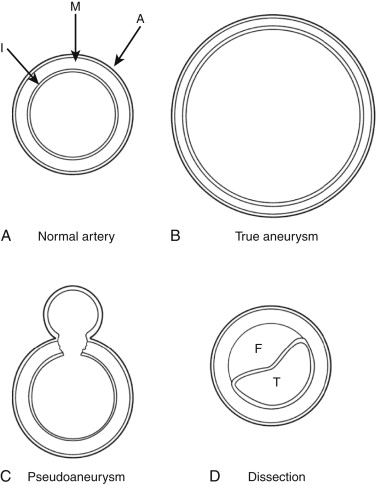
True aneurysms are associated with a number of risk factors ( Box 1-2 ). In general, focal enlargement of an artery to more than 1.5 times its normal diameter constitutes an aneurysm. The most common type of true aneurysm is degenerative. The pathogenesis of degenerative aneurysm formation is not yet fully understood, but may involve atherosclerotic, mechanical (i.e., post-stenotic dilatation), enzymatic, autoimmune, and potentially infectious mechanisms. For example, metalloproteinases are proteolytic enzymes synthesized by macrophages that are elevated in patients with abdominal aortic aneurysms. The levels drop to normal following successful repair by either surgical or endovascular techniques. Regardless of the mechanism, aneurysm formation is associated with thinning of the media and loss of smooth muscle cells, elastic fibers, and collagen.
Age older than 60 years
Hypertension
Male
Atherosclerosis
Familial
Chronic obstructive pulmonary disease (aortic aneurysms)
Heritable disorders
Marfan syndrome
Ehlers-Danlos syndrome
Loeys-Dietz syndrome
Vasculitis
Post-stenotic jet or turbulence
Repetitive trauma
Degenerative aneurysms are often multifocal, occurring in large to medium-sized arteries in numerous vascular beds in a single patient. The most common arteries in which aneurysms are found are the abdominal and thoracic aortas, the common iliac, internal iliac, common femoral, popliteal, subclavian, and visceral arteries. External iliac and extracranial carotid artery aneurysms are rare. Generalized enlargement without focal aneurysm formation is termed arteriomegaly .
Aneurysms of large arteries most often cause symptoms by rupturing (especially the aorta, common iliac, and internal iliac arteries) ( Fig. 1-10 ). Symptoms due to mass effect are less common but well described. Aneurysms of visceral arteries most often present clinically with rupture. Aneurysms of most other small and medium arteries (exclusive of the intracranial circulation) typically present with symptoms related to thrombosis and distal embolization (see Fig. 1-7 ). All aneurysms can become secondarily infected.
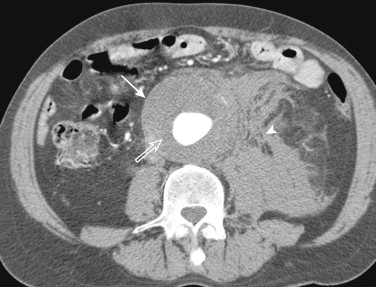
False aneurysms are focal enlargements of the vascular lumen due to partial or complete disruption of the arterial wall (see Fig. 1-9 ). The blood is contained by residual elements of the arterial wall or surrounding tissues. Also known as pseudoaneurysms (PSAs), they are more prone to rupture than similar sized true aneurysms. The cause of most PSAs encountered in clinical practice is iatrogenic, such as surgery, angiography, or percutaneous biopsies. Penetrating wounds, crush injuries, and deceleration injuries are common etiologies of PSA occurring outside of the hospital. In addition, PSA may result from contained rupture of true aneurysms or vascular infection (mycotic aneurysm).
Fibromuscular dysplasia (FMD) is a collection of fibrotic disorders of the intima, media, or adventitia of medium-sized arteries ( Table 1-4 ). The most frequently affected arteries are the renal, extracranial internal carotid, vertebral, iliac, subclavian, and mesenteric arteries. The etiology of this nonatherosclerotic, noninflammatory abnormality is unknown, but it tends to be found in young adult female patients. The most common subtype is medial fibroplasia, in which focal weblike stenoses alternate with small aneurysms of varying sizes (“string of natural pearls”). Figure 1-11 shows the characteristic angiographic appearance. Medial fibroplasia causes symptoms by obstructing flow (webs), distal embolization (of thrombus formed in the small aneurysms), and occlusion (spontaneous dissection). Other forms of FMD result in tapered stenoses that are less characteristic in appearance, but unusual in that patients tend to be young and without evidence of atherosclerotic disease. Precise classification of the less common forms of FMD requires pathologic specimens.
| Type | Incidence | Predominant Features |
|---|---|---|
| Medial fibroplasia | 85% | Alternating webs and aneurysms |
| Medial hyperplasia | 10% | Tubular smooth stenosis |
| Perimedial fibroplasia | 3% | Irregular, beaded stenosis |
| Intimal fibroplasia | 1% | Focal smooth stenosis |
| Periarterial fibroplasia | 1% | Tubular smooth stenosis |
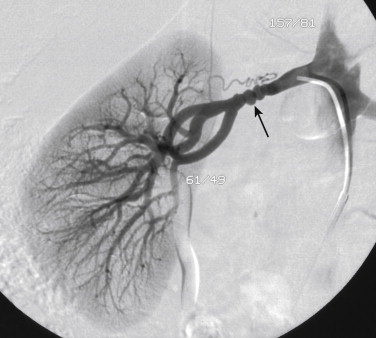
FMD is frequently a bilateral and multifocal abnormality. In most cases, asymptomatic disease remains stable throughout the patient’s life. Symptomatic medial fibroplasia responds well to balloon angioplasty. The experience with angioplasty in other forms of FMD is limited but favorable, although normal caliber lumens are rarely achieved.
Vasculitides are inflammatory diseases of the vessel wall due to unknown causes. Inflammation due to infection is considered a mycotic process and is discussed later (see Infection). Vasculitis most commonly involves arteries, but veins can sometimes be affected. The vasculitides encountered most often in vascular imaging are those that involve large arteries (e.g., Takayasu arteritis, giant cell arteritis, and Behçet disease) and medium arteries (e.g., polyarteritis nodosa, Kawasaki disease, and Buerger disease). There are numerous types of vasculitis, most of which are associated with constitutional symptoms such as fever, arthralgia, myalgia, rash, and malaise ( Table 1-5 ).
| Syndrome | Vasculature Affected | Imaging Findings |
|---|---|---|
| Takayasu arteritis (“pulseless disease”) | Large: thoracic and abdominal aorta, proximal great vessels, pulmonary arteries, coronary arteries | Thickened enhancing arterial wall on CT/MRI; long aortic stenoses; long smooth non-ostial common carotid and subclavian stenoses; pulmonary artery stenosis; coronary artery stenosis; aortic aneurysm (especially ascending) |
| Giant cell arteritis | Large: subclavian, axillary, brachial arteries; carotid artery branches; aorta; visceral arteries (rare) | Long irregular stenoses and occlusions; aortic aneurysm/dissection |
| Polyarteritis nodosa | Medium and small arteries of kidney, liver, bowel, pancreas, spleen, and extremities | Micro and small aneurysms; segmental stenoses with normal skip areas; occlusions |
| Kawasaki disease (mucocutaneous lymph node syndrome) | Medium and small arteries | Coronary and medium-sized artery aneurysms |
| Buerger disease (thromboangiitis obliterans) | Medium and small arteries of the extremities; extremity veins; visceral arteries (rare) | Occlusion of all named vessels with centripetal progression and extensive per-vascular collaterals via vasa vasorum; migratory thrombophlebitis in 30% |
| Behçet disease | All: large and medium arteries; pulmonary arteries, systemic veins | Venous thrombosis; peripheral and aortic aneurysms; arterial thrombosis; pulmonary artery aneurysm |
| Radiation arteritis | All arteries | Varies with time; early thrombosis or late stenosis, with few collaterals |
| Systemic lupus erythematosus, scleroderma | Small arteries, usually upper extremity | Variable length tapered stenoses and occlusions, especially digital arteries |
| Rheumatoid arthritis and other HLA-B27 disorders | Thoracic aorta | Aortic root dilatation |
An elevated erythrocyte sedimentation rate (ESR) is common unless the disease has been treated or has spontaneously regressed (“burned out”). Numerous other more specific serologic markers may also be elevated, depending upon the type of vasculitis.
The diagnosis of vasculitis is usually well established before the patient is referred for imaging. The radiographic features of many of the different vasculitides overlap, such that a specific diagnosis may not be possible from the imaging studies. The diagnosis of vasculitis should be entertained whenever arterial disease such as wall thickening (especially with enhancement), bizarre-appearing stenoses, or dilations alternating with normal “skip” areas, or aneurysms, are found in unusual locations.
Takayasu arteritis is a panarteritis that involves the aorta, its major branches, and, less often, the pulmonary arteries. The cause of Takayasu arteritis is unknown, but it is presumed to be autoimmune. In the United States, the prevalence is roughly 0.5 persons per 100,000 person-years. There are no ethnic or racial predilections. The typical patient is a female in her second or third decade. Granulomatous changes and lymphocytic infiltration thicken the intima and media, leading to compromise of the lumen. Chronic inflammation may also result in aneurysmal changes. There are five basic patterns of distribution of lesions, with panaortic involvement being the most common ( Fig. 1-12 ). It is important to note that cardiac disease is present in 40% of patients, including coronary artery stenoses, aortic and mitral valvular insufficiency, and right heart failure due to pulmonary artery stenoses. A distinctive feature of active Takayasu arteritis is wall enhancement following administration of contrast on computed tomography (CT) or magnetic resonance imaging (MRI) ( Fig. 1-13 ).

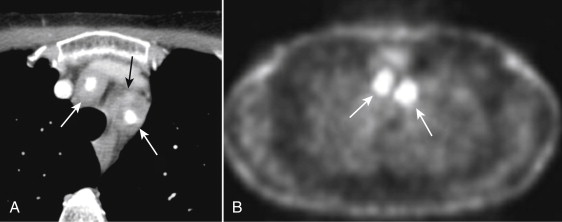
Takayasu arteritis is also known as “pulseless disease,” because stenoses or occlusions of the proximal subclavian and common carotid arteries are common ( Fig. 1-14 ; see also Fig. 9-31 ). Patients may present with renal hypertension due to abdominal aortic stenoses proximal to or involving the renal arteries. The stenotic lesions are usually long and smooth, although associated plaque may be present in longstanding aortic lesions of older patients. Aortic aneurysms, which are found in up to one-third of patients, rarely rupture. Treatment of uncomplicated Takayasu arteritis is with steroids.
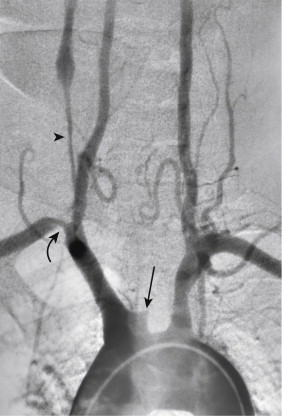
Polyarteritis nodosa (PAN) is a systemic necrotizing vasculitis that affects primarily small and medium-sized arteries of the abdominal visceral organs, the heart, and the hands and feet. Patients are usually in their fourth or fifth decade, but may be of any age. Males are affected twice as often as females. There is a strong association between PAN and active hepatitis types B and C, as well as intravenous drug abuse, but more than 50% of patients have no known cause. Patients have constitutional, dermatologic, and neurologic manifestations, as well as abdominal pain, renal insufficiency, and spontaneous intraabdominal or retroperitoneal hemorrhage. The angiographic lesions are characteristic, with multiple small aneurysms of the renal or visceral arteries, and digital artery occlusions ( Fig. 1-15 ). Treatment is with steroids and cyclophosphamide.
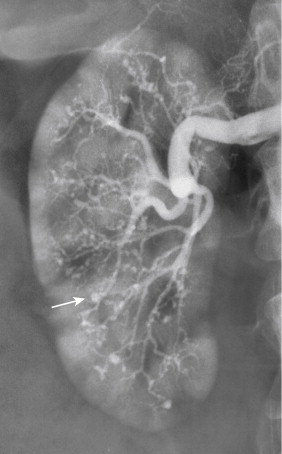
Giant cell arteritis derives its name from the presence of giant cells in the infiltrative process in all layers of the blood vessel wall. Mononuclear cells, lymphocytes, T-cells, and macrophages are more commonly present. Patients with giant cell arteritis are generally much older than those affected by Takayasu arteritis, which it can resemble. The classic presentation is in an older woman who suffers several weeks of fever, headaches, palpably tender temporal arteries, myalgias, and an extremely elevated ESR; also called temporal arteritis . Acute blindness due to involvement of the ophthalmic artery is a feared complication (40% in untreated patients). Diagnosis in these patients is most often by temporal artery biopsy.
Giant cell arteritis also causes stenoses of the extremity arteries (upper more often than lower) that manifest 8-24 weeks after onset of symptoms. The arteries involved most often are the distal subclavian, the axillary, and the proximal brachial arteries, although a pattern very similar to Takayasu arteritis may be seen ( Fig. 1-16 ). These patients are more likely to be referred for angiography to evaluate upper extremity ischemic symptoms. The appearance of multiple, long, irregular stenoses of these arteries is characteristic, although rarely other vasculitides, such as that associated with systemic lupus erythematosus (SLE), may produce similar lesions. Rarely, thoracic or abdominal aortic aneurysms may develop in patients with giant cell arteritis and may be the only presenting symptom. Rupture and dissection have been reported in these patients.
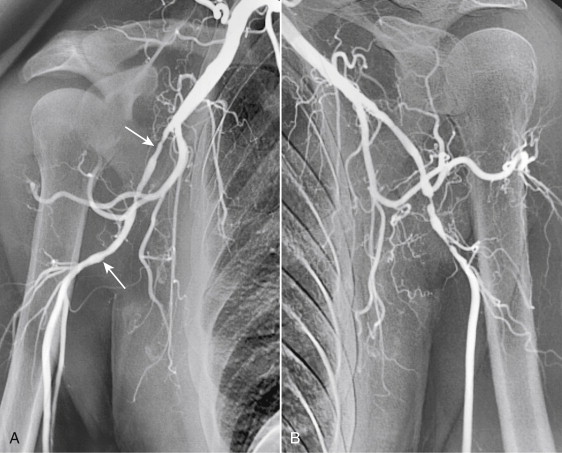
Buerger disease is also known as thromboangiitis obliterans because of the inflammatory cellular debris that occludes the vessel lumen. Even though the disease is a panarteritis, the vessel wall remains relatively intact, including the elastic lamellae. The distal small to medium arteries and veins of the lower and upper extremities are most commonly involved, usually with preservation of the proximal inflow vessels. Rarely, visceral, iliac, coronary, and pulmonary arteries can be involved. Buerger disease primarily affects male smokers younger than age 50, although female patients now comprise almost one third of all cases. This diagnosis should be suspected in any young patient presenting with small-vessel occlusive disease in the absence of diabetes. The lower extremities are almost always involved, and the upper extremities are involved in more than half of patients. A migratory thrombophlebitis, usually of the superficial veins, is seen in up to 30% of patients. The incidence of Buerger disease has decreased dramatically in the last 50 years, for reasons as yet unknown.
The angiographic appearance of Buerger disease is dramatic, with occlusion of most or all named vessels below the knee or elbow ( Fig. 1-17 ). Because the vessel wall architecture is preserved, prominent collaterals develop in the vaso vasorum of the occluded arteries. This results in a typical “corkscrew” appearance of collaterals on angiography, quite distinct from collaterals resulting from atherosclerotic occlusions.
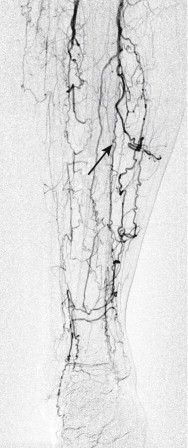
Behçet disease presents with recurrent oral and genital aphthous ulcers, skin lesions, ocular inflammation, arthritis, gastrointestinal symptoms, and epididymitis. Patients are usually between 20 and 40 years of age. Males are affected more commonly than females, at a ratio of almost 2:1. Pathologically, Behçet disease is an inflammatory disorder of small blood vessels, in particular venules. The clinical vascular manifestations of Behçet disease occur in 20% of cases, with superficial venous thrombosis predominating. Aortic and pulmonary artery aneurysms, arterial occlusive disease, and central venous thrombosis occur in less than 5% of patients ( Fig. 1-18 ).
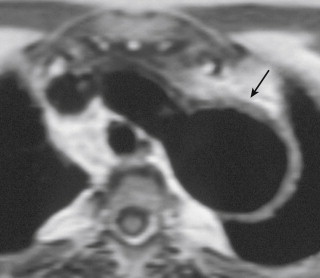
Radiation arteritis is the result of injury to radiosensitive endothelial cells during external beam radiation for malignancy. Symptoms occur when the total radiation dose exceeds 50 Gray. The clinical presentation varies with the time interval from the radiation exposure. Thrombosis is most common within 5 years of treatment; mural fibrosis, stenosis, and occlusion with a paucity of collaterals occur between 5 and 10 years after treatment. Late manifestations include periarterial fibrosis and accelerated atherosclerosis, often in unusual distributions localized to the irradiated tissues ( Fig. 1-19 ). New techniques for delivering radiation and careful planning limit the incidence of this complication.
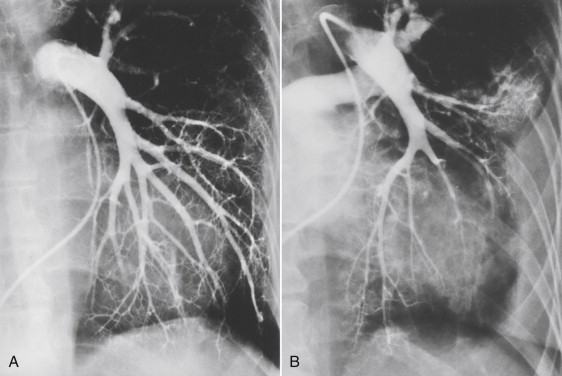
Kawasaki disease, also known as mucocutaneous lymph node syndrome , is a rare disease of infants and children younger than 1 year. A vasculitis affects primarily small and medium-sized arteries. The most notable presenting vascular abnormality is coronary artery aneurysm, which may thrombose or rupture. Aneurysms of other arteries occur as well. This disease has been rarely reported in patients older than 9 years of age.
Systemic lupus erythematosus (SLE) and other collagen vascular diseases are usually characterized by musculoskeletal symptoms and serologic markers. Diagnosis is rarely made on the basis of angiographic findings alone. More commonly, patients with a known connective tissue disorder develop symptoms that suggest vascular involvement, such as digital ischemia and ulcerations. In these cases, angiography is performed to exclude another, correctable problem such as digital arterial emboli. The typical angiographic findings of lupus vasculitis in the hand are focal occlusions and irregular stenoses of the palmar and digital arteries ( Fig. 1-20 ). Similar lesions may be seen in scleroderma.
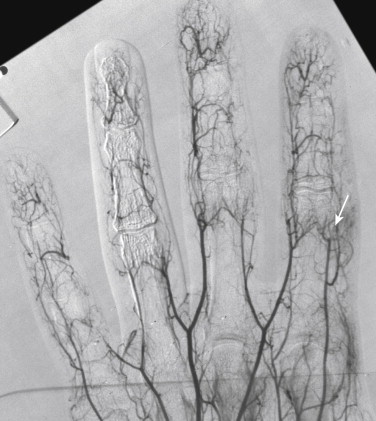
Patients with rheumatoid arthritis, ankylosing spondylitis, reactive arthropathy, and psoriatic arthritis can develop ascending aortic dilatation with aortic valve insufficiency. These patients are also prone to aortic dissection.
Become a Clinical Tree membership for Full access and enjoy Unlimited articles
If you are a member. Log in here